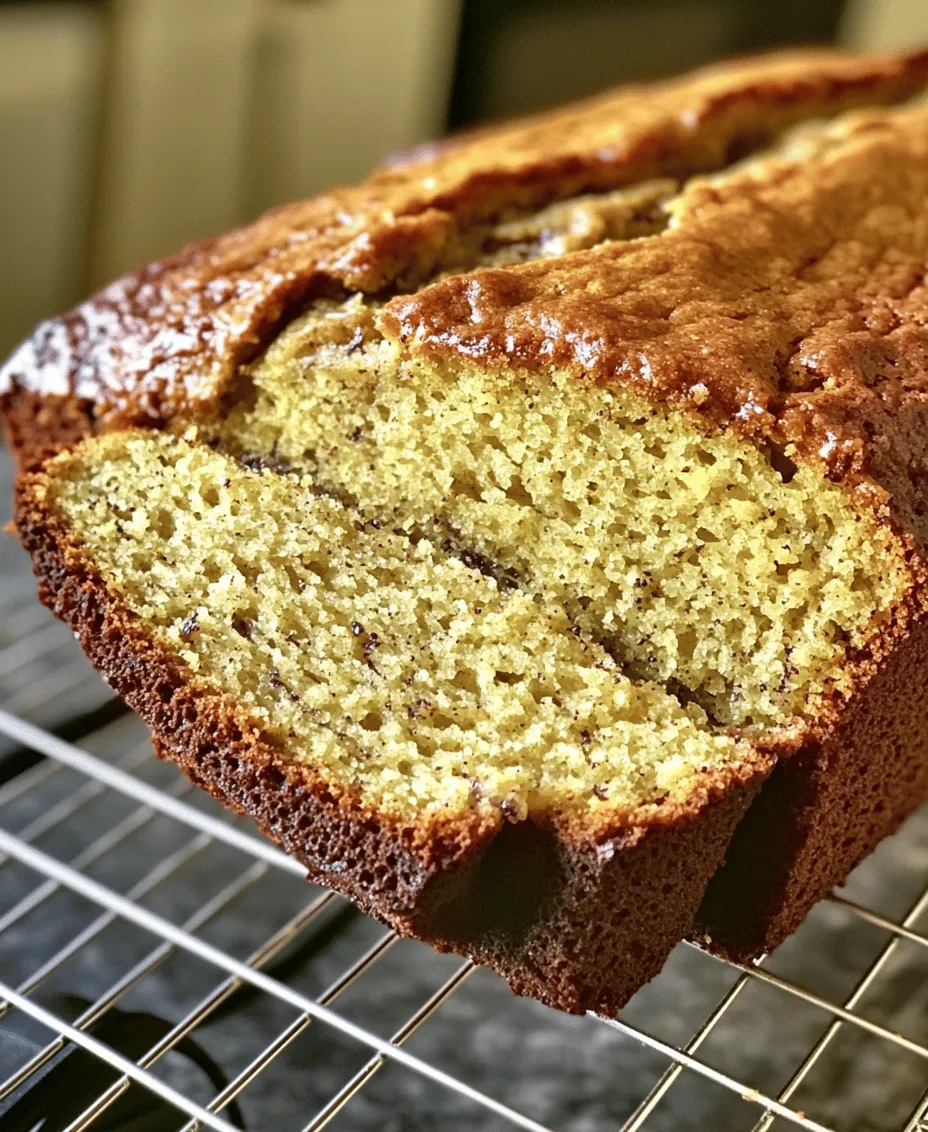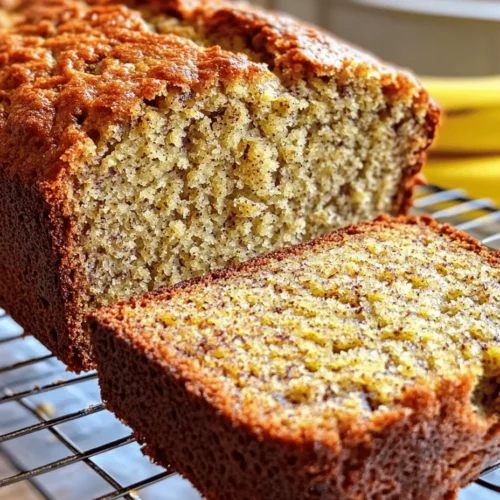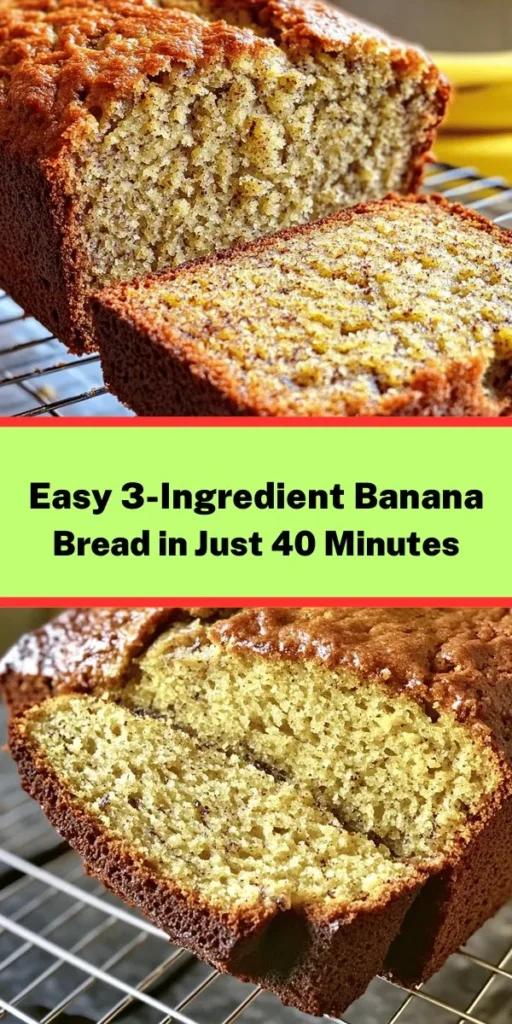Banana bread is one of those beloved comfort foods that transcends generations, a staple in many homes. Its warm, sweet aroma wafting through the kitchen brings back cherished memories of family gatherings and cozy afternoons spent with loved ones. This delightful treat has garnered a special place in our hearts, not only for its comforting flavor but also for its versatility. Over the years, banana bread has evolved from a simple way to use overripe bananas into a culinary canvas for creativity, accommodating various dietary preferences and flavor profiles.
In today’s fast-paced world, where convenience and simplicity reign supreme, the popularity of quick and easy recipes has surged. Home cooks, whether seasoned chefs or beginners, are always on the lookout for ways to whip up delicious meals without spending hours in the kitchen. Enter the 3-ingredient banana bread—a straightforward solution that perfectly aligns with our modern need for efficiency and satisfaction. This recipe not only minimizes time spent on preparation but also reduces the complexity of cooking, making it an ideal choice for busy individuals and families alike.
The Allure of 3-Ingredient Recipes
The appeal of 3-ingredient recipes lies in their simplicity and convenience. In a culinary landscape often flooded with complicated dishes requiring a long list of ingredients, recipes that can deliver big flavors with minimal ingredients stand out. These recipes enable even the most novice cooks to find success in the kitchen without the fear of overwhelming themselves.
Minimalism in cooking has become a trend for a reason. It allows for a more focused approach to flavor, stripping down the unnecessary elements and honing in on the essentials. With fewer ingredients, the unique qualities of each component can shine through, creating a harmonious balance of taste and texture. In the case of our 3-ingredient banana bread, the ripe bananas, self-rising flour, and sugar come together to create a moist, sweet loaf that is both satisfying and uncomplicated.
Ingredients Breakdown: What You’ll Need
To create this delightful 3-ingredient banana bread, you’ll need just three key components. Let’s take a closer look at each ingredient and their roles in crafting this easy yet delicious treat.
Ripe Bananas
The cornerstone of any banana bread is, of course, the bananas. The importance of ripeness cannot be overstated—ideal bananas for this recipe are those that are spotty, soft, and very ripe. Overripe bananas are sweeter and have a more pronounced banana flavor, which is crucial for achieving a moist and flavorful bread. If you have bananas that are past their prime, don’t toss them out! Instead, embrace their ripeness, as they will enhance the taste and texture of your banana bread.
Self-Rising Flour
Self-rising flour is another essential ingredient in this recipe. Unlike all-purpose flour, self-rising flour contains a leavening agent (usually baking powder) and salt, which eliminates the need for additional leaveners in your banana bread. This makes it a perfect choice for a simple recipe like this one, as it helps the bread rise beautifully, creating a light and fluffy texture. If you don’t have self-rising flour on hand, you can easily make your own by combining all-purpose flour with baking powder and a pinch of salt.
Sugar
Sugar is the third ingredient that rounds out this banana bread. It not only adds sweetness to the loaf but also contributes to the overall texture and moisture. The amount of sugar can be adjusted based on your taste preferences and the ripeness of your bananas. For those seeking a healthier alternative, you might consider using natural sweeteners or reducing the sugar altogether. Remember, the key is to find a balance that suits your palate while still ensuring a delicious result.
When sourcing your ingredients, opt for high-quality, fresh produce and flour. The flavor of your banana bread will heavily rely on the quality of the bananas and flour, so choose wisely for the best results.
Step-by-Step Instructions for Easy Banana Bread
Now that you have a clear understanding of the ingredients, let’s dive into the step-by-step instructions to create your 3-ingredient banana bread. Follow these detailed steps to ensure a successful baking experience.
Preheating the Oven and Preparing the Loaf Pan
Begin by preheating your oven to 350°F (175°C). This is an important step, as it ensures that your banana bread bakes evenly and thoroughly. While the oven is heating, prepare your loaf pan. Grease it lightly with cooking spray or line it with parchment paper to prevent sticking. Proper pan preparation is crucial for an easy release once the bread is baked.
Mashing Bananas
Once your oven is preheated, it’s time to prepare the bananas. Place your ripe bananas in a large mixing bowl. Using a fork or a potato masher, mash the bananas until they reach a smooth consistency with only small lumps remaining. The goal here is to break down the bananas sufficiently so that they will integrate well into the batter, providing moisture and flavor. The more thoroughly you mash them, the smoother your banana bread will be.
Mixing Ingredients
Next, add the self-rising flour and sugar to the mashed bananas. Using a spatula or wooden spoon, gently combine the ingredients. It’s important to mix just until everything is incorporated—over-mixing can lead to a dense loaf. You want to maintain the lightness that self-rising flour provides. The mixture should be thick but pourable, with no dry flour clumps remaining.
Pouring and Smoothing the Batter
Once your batter is well mixed, pour it into the prepared loaf pan. Use the spatula to smooth the top, ensuring an even surface. This will help the bread bake evenly and rise nicely.
Baking Time and Signs of Doneness
Place the loaf pan in the preheated oven and bake for about 50 to 60 minutes. The exact time may vary based on your oven, so keep an eye on it. You’ll know your banana bread is done when the top is golden brown and a toothpick inserted in the center comes out clean or with a few moist crumbs clinging to it.
Cooling and Serving
After removing the banana bread from the oven, let it cool in the pan for about 10 minutes. This step is essential, as it allows the bread to set and makes it easier to transfer to a wire rack. After that, gently remove the loaf from the pan and let it cool completely on the wire rack. Cooling on a rack prevents moisture from accumulating at the bottom, ensuring a delightful, non-soggy loaf.
As you wait for your banana bread to cool, you can start planning how you’d like to serve it. Whether enjoyed plain, slathered with butter, or paired with your favorite spreads, this easy banana bread is bound to be a hit!
Exploring Variations and Customizations
While this recipe offers a simple and straightforward approach to banana bread, there’s plenty of room for creativity. Once you’ve mastered the basic recipe, consider experimenting with various add-ins or flavorings to make it your own.
Stay tuned for Part 2, where we’ll delve deeper into exciting variations and customizations that can elevate your 3-ingredient banana bread to the next level.

Ideas for Adding Flavors or Ingredients to the Basic Recipe
While the 3-ingredient banana bread is delightfully simple and delicious on its own, there are countless ways to elevate its flavor profile and customize it to your preferences. Here are some ideas to enhance your banana bread:
Nuts: Incorporating nuts like walnuts or pecans can add a satisfying crunch and depth of flavor. Chop them coarsely and fold them into the batter before baking. Nuts not only enhance the texture but also provide healthy fats and protein, making your banana bread even more nutritious.
Chocolate Chips: For chocolate lovers, adding chocolate chips is a perfect way to create a sweet twist on the classic recipe. Whether you choose semi-sweet, dark, or even white chocolate chips, they melt into the bread as it bakes, creating pockets of gooey goodness.
Spices: A sprinkle of spices can transform your banana bread into a warm and inviting treat. Consider adding ground cinnamon or nutmeg to the batter for an extra layer of flavor. These spices complement the sweetness of the bananas and provide a comforting aroma that fills your kitchen.
Adjusting the Recipe for Dietary Preferences
The beauty of banana bread is its versatility, which allows it to cater to various dietary needs. Here are some adjustments you can make:
Gluten-Free Alternatives: If you’re looking for a gluten-free option, you can easily swap out regular flour for gluten-free flour blends. Many brands offer all-purpose gluten-free flour that works well in baking. Just ensure that your baking powder is also gluten-free to maintain the integrity of the recipe.
Sugar Substitutes for Healthier Options: For those watching their sugar intake, consider using natural sweeteners like honey, maple syrup, or agave syrup instead of refined sugar. Keep in mind that these alternatives may alter the texture slightly, so adjust the liquid content of your batter accordingly. Additionally, ripe bananas provide natural sweetness, so you may even find you can reduce the sugar content significantly without sacrificing flavor.
Nutritional Benefits of Banana Bread
Understanding the nutritional benefits of each ingredient can make your banana bread not only delicious but also a more wholesome choice. Here’s a brief analysis:
– Bananas: The star of the show, bananas are a powerhouse of nutrients. Rich in potassium, they help support heart health and maintain proper muscle function. They’re also a great source of dietary fiber, which aids digestion and helps you feel fuller longer.
– Eggs and Flour: The eggs contribute protein, essential for muscle repair and growth, while the flour adds carbohydrates for energy. If you opt for whole wheat flour, you’ll also benefit from additional fiber and nutrients.
– Optional Add-ins: Nuts provide healthy fats and protein, while chocolate chips can offer antioxidants, especially if you choose dark chocolate. Spices like cinnamon can also have health benefits, including anti-inflammatory properties.
By balancing indulgence with nutritious ingredients, you can enjoy banana bread that satisfies your sweet tooth while still being health-conscious.
Troubleshooting Common Issues
Even the simplest recipes can sometimes lead to unexpected results. Here are some common issues you might encounter while baking banana bread, along with tips to troubleshoot them:
Dense or Gummy Banana Bread: If your banana bread turns out dense or gummy, it might be due to overmixing the batter or using too many bananas. Mix the ingredients until just combined and avoid over-mashing the bananas. Use two medium-sized ripe bananas for the best texture.
Achieving the Perfect Crust and Crumb: For a beautifully golden crust, make sure your oven is preheated correctly. Baking at a consistent temperature is key. If the top browns too quickly, you can cover it with aluminum foil midway through baking. For a moist crumb, ensure you don’t overbake your bread; a toothpick inserted in the center should come out clean but not dry.
Storing Banana Bread for Freshness: To keep your banana bread fresh, allow it to cool completely before storing. Wrap it tightly in plastic wrap or aluminum foil to prevent moisture loss. For longer storage, consider freezing individual slices. Simply wrap each slice and place them in a freezer-safe bag. When you’re ready to enjoy a piece, thaw it at room temperature or pop it in the microwave for a few seconds.
Cultural Significance and History of Banana Bread
Banana bread has a rich history that spans cultures and continents. Originating in the United States during the Great Depression, it became a popular way to use overripe bananas, which were often overlooked. The recipe gained traction as home baking became a vital skill during economic hardship.
Over the years, different cultures have embraced banana bread, each adding their unique twists. In the Caribbean, banana bread often features spices like nutmeg and allspice, reflecting local flavor profiles. In some Asian countries, banana bread is combined with coconut or tropical fruits, enhancing its sweetness and richness.
Personal anecdotes about banana bread often evoke warm memories of family gatherings or baking sessions with loved ones. Many people recall the comforting aroma wafting through the kitchen as it bakes, creating a sense of nostalgia and connection to home.
Conclusion: The Joy of Baking Simple Treats
In conclusion, the 3-ingredient banana bread is not just a recipe; it’s an invitation to explore the joys of baking. Its simplicity allows bakers of all skill levels to create a delightful treat with minimal effort. The versatility of banana bread encourages experimentation with flavors, dietary adjustments, and personal touches, making each loaf a unique creation.
Embrace the opportunity to bake as a joyful activity, allowing the process to bring comfort and satisfaction to your life. Whether you enjoy it warm with a pat of butter, as a snack on the go, or as a sweet treat to share with friends, banana bread never fails to deliver happiness. So gather your ingredients, preheat your oven, and indulge in the delightful experience of baking this timeless classic.



